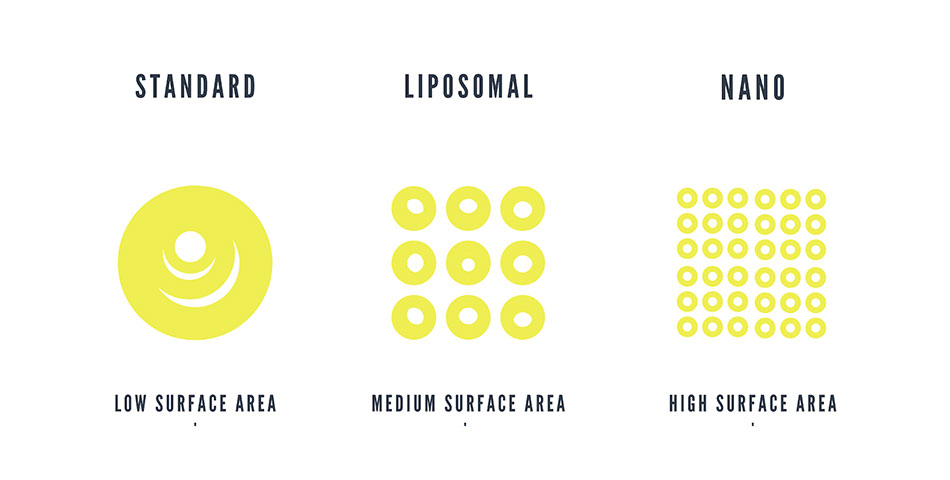Nano CBD Oil: What It Is, What It Does, and Its Future
CBD has come a long way in the past couple of years.
It’s been legalized, popularized, normalized . . . and we’re thankful.
But despite the CBD industry’s huge year-over-year growth, most actual CBD products out there have remained largely unchanged. And most brands are still manufacturing basic CBD tinctures—tinctures that pretty much amount to simply taking hemp extract and olive oil, throwing them in a bottle, and calling it good!
We believe today’s CBD consumer deserves better . . . much better.
More specifically, today’s consumer deserves a CBD product that’s actually compatible with their body: the nano-emulsified CBD tincture.
Maybe you’ve already heard about nano CBD, which is sometimes called liposomal CBD. Great! But you probably still have questions . . . and it’s our hope that this comprehensive guide to nano CBD will help. Here’s an outline of what you can expect below:
But before jumping right into the details of nano-enhanced CBD, let’s take a look back at what makes CBD itself so special in the first place.
The Benefits of CBD (A Refresher)
There’s a reason CBD has become so popular. The stuff is amazing!
CBD use has been correlated with everything from improved sleep to reduced pain to a stabler mood . . . in both scientific studies and real life. Having transcended typical disease-specific supplements, CBD has quickly become the plant compound we didn’t know we needed.
Its potential medical applications look good, too. Even the normally-reserved FDA admits that “CBD has been shown to be beneficial in experimental models of several neurological disorders, including those of seizure and epilepsy.” Just as telling, the US Department of Health and Human Services actually has a patent on CBD and its utility as an antioxidant
Here’s an excerpt of their viewpoint:
“. . . Cannabinoids are found to have particular application as neuroprotectants, for example in limiting neurological damage following ischemic insults, such as stroke and trauma, or in the treatment of neurodegenerative diseases, such as Alzheimer’s disease, Parkinson’s disease and HIV dementia . . . “
Then there’s the less-easy-to-measure-but-just-as-important fact that for many people, CBD boosts cognitive function and gets the creative juices flowing. Regardless of whether you’re an artist or an executive…a content creator or professional musician…a chronic creative or occasional dabbler, CBD could quickly become your supplement of choice.
CBD Absorption: It Can Be A Problem!
As great as CBD is, however, there’s one big drawback: its absorption rates
In many ways hemp and humanity are a match made in health & wellness heaven . . . but in other ways a mediator is sometimes needed.
That’s because CBD (along with pretty much every other active ingredient in hemp) is fat-soluble. It’s produced within the oily, resinous glands of mature hemp, a place where fat-based substances feel right at home.
The human body, on the other hand, is 60% water. We simply can’t get by without the stuff, and neither can the metabolic machinery which processes everything we ingest. With few exceptions, our bodies absorb water-soluble compounds better than any other type. This leaves most CBD products out there in a less-than-optimal position. The fact that many brands source their CBD oil from overprocessed CBD isolate doesn’t make things any better.
Yet the CBD industry, on a whole, has been slow to change. Maybe they feel that ‘regular’ CBD works well enough. Why fix what’s not broken, as the saying goes. Why be unsatisfied with the good results that even low-quality CBD isolate sometimes gives?
Because recent advancements in CBD science are finally changing things, that’s why! CBD can now work better than ever. Here’s how.
The Discovery of Liposomes
“Liposomes have been considered as one of the most outstanding, versatile and flexible carrier systems.”
A lot of substances, as it turns out.
First, pharmaceutical drugs and anti-cancer medications went liposomal, and the nutraceutical industry eventually followed suit. By the early 2000s both vitamin C and vitamin D were being produced liposomally.
Even the cells within our bodies fit the definition of liposomes. That’s right—they have a sealed internal matrix surrounded by a structured lipid bilayer. This similarity is one of the reasons non-living liposomes were studied in the first place! Suffice it to say that the liposome is as natural as it gets.
Nano CBD Oil

So it’s only natural that CBD products would adopt the liposomal approach eventually.
Science has just discovered how to make this possible . . . and now, CBD’s bioavailability problem can finally be solved.
The best liposomal CBD uses nanotechnology to take the traditional liposome one level higher. How is nano-enhanced CBD made? Good question! It requires a process called nano-emulsification, where CBD molecules are separated from each other and gently wrapped within a fat-based bilayer. When in this special form, CBD can be dispersed quickly and evenly throughout virtually any liquid, whether it’s your favorite drink or your bloodstream itself. Indeed, nano CBD is also hydrophilic, which literally means “water-loving.”
And the best nano-enhanced CBD is truly nano. While a traditional liposome may be between two hundred and five thousand nanometers in size, CBD nano-particles are only 25 nanometers each. A strand of human hair is thousands of times wider . . . and a single human mitochondrion isn’t much smaller.
While the ability to enhance CBD with nanotechnology is cutting-edge, you don’t need to be daunted by it. As mentioned earlier, liposomes exist throughout nature; both soap and some types of vitamin C are liposomal substances. Nano-enhanced CBD simply harnesses a similar nature-inspired technology.
CBD’s Bioavailability . . . and How to Enhance It
Next, let’s dive into more specific benefits of nano CBD. Compared to traditional CBD, nano CBD is:
- Absorbed 4-5 times more completely
- Capable of kicking in up to 10 times faster
- Able to provide longer-lasting health benefits
- Able to bypass liver metabolism and breakdown
- Easier to digest, especially for those with gut health problems
- Water-soluble (and therefore easy to incorporate into drinks!)
Many people also wonder if nano CBD is faster acting than the regular stuff. As you can see from the above, yes it is! That’s because the absorption of any CBD oil begins the minute it hits the inside of your mouth. The mouth is home to something called the oromucosal membrane.
As soon as a CBD oil’s active ingredients touch this membrane, good things start to happen. In fact, when one is dealing with nano CBD, this is where most of the magic happens. By quickly absorbing through these sensitive spots, nano CBD is able to kick in within seconds and bypass liver metabolism almost entirely. Just like liposomal vitamin C, nano CBD acts as a true sublingual.
Nano-emulsified CBD is also truly water-loving. It meshes well with anything that’s water-based—your favorite tea, a hot (or cold!) cup of coffee, or a drink on the go—making CBD that much more fun and effortless.
A Price Comparison

Water solubility isn’t the only practical benefit of going the nano route.
Another huge benefit is cost savings. At first glance that might seem surprising, and we get it. If 500 mg of traditional CBD oil costs $50 and 500 mg of nano CBD oil costs $60 . . . how does that work?
It’s a valid question. But while that generic 500mg CBD oil product might seem cheaper, there’s more to things here than meets the eye. Consider how much of the product is actually absorbed into your bloodstream: according to this 2018 review study, “the oral bioavailability of CBD has been shown to be very low (13–19%).”
When taken as a true sublingual, CBD oil might reach 30% . . . but this is rare. For the sake of comparison, let’s say CBD oil’s bioavailability is usually 20%, max.
20% of 500 milligrams is 100 milligrams. This product’s real price per milligram value? 50 cents for every single milligram of active CBD that’s actually used by your body. Pretty steep.
Contrast that with the bioavailability of nano CBD—which according to initial studies seems to hover around 55%-60%. Here’s what the studies say:
- Maximal absorption “is increased and reached faster after oral administration [ . . . ] in a pro-nanoliposphere formulation” [1]
- “The highly lipophilic nature of cannabinoids means that they are seen as suitable candidates for advanced nanosized drug delivery systems.” [2]
- “The [nanoparticle] formulation proposed proved to be a promising carrier for theoral delivery of CB13, a cannabinoid with high therapeutic potential.” [3]
So . . . let’s say nano CBD’s absorption is 55%, just to be conservative. 55% of 500 mg is 275 mg.
Nano CBD’s real price per milligram? 18 cents for every milligram of active CBD! Even with these conservative figures, nano CBD is about three times more affordable than the regular stuff. That means you can take less CBD and still get better results in the long run.
Nano CBD: Pros and Cons
Even within the nano-products world, not all CBD is created equal. Some brands formulate their nano CBD with harsh solvents like propylene glycol.
Still other brands settle for nano-emulsified preparations that aren’t truly nano in nature. As we said earlier, it’s not unheard of for nano CBD particles to be up to 5,000 nanometers in size! That’s not an outright bad thing—but compared to the ideal 25nm nanoparticle, it doesn’t really measure up.
And even nano CBD won’t be maximally effective if it’s not full spectrum. Clinical Research from the world-leading Hebrew University of Jerusalem has demonstrated that CBD isolate is approximately four times less effective than whole plant extracts. You can thank hemp’s impressive terpene content for much of the difference.
Four times. That’s pretty significant! Significant enough to imply that isolate products (like non-nano ones) aren’t the most health- or cost-effective choice, at least. These oils also miss out on the compound-to-compound synergy known to science as the entourage effect, which is where hemp’s most active ingredients work together to provide a greater overall effect.
As Dr. Ethan Russo explains in his landmark study on the subject, “[ . . . ] one molecule is unlikely to match the therapeutic and even industrial potential of Cannabis itself as a phytochemical factory.”
Nano CBD and Terpenes
So far we’ve looked through several different generations of CBD products. First, there was the traditional CBD oil, then hydrophilic (aka water-soluble) nano CBD oil, then full spectrum, hydrophilic nano CBD. Here’s a quick comparison:
-
- ‘Traditional’ CBD Oil | Low bioavailability of 13%–19% | Slow onset time | Moderate cost
-
- Hydrophilic Nano CBD Oil | High bioavailability of 55%-60% | Fast onset time | Higher cost
-
- Full Spectrum Nano CBD Oil | High bioavailability of 60% + | Ultra-fast onset time | Higher cost
As you can see, full spectrum nano CBD is the compound’s best iteration yet. It represents a near-perfect union of nature and technology . . . a CBD that’s provided by hemp yet mediated by science.
But things can still get one evolution better. You deserve the best, remember?
Even full spectrum hemp becomes more powerful when it’s allowed to synergize with other botanicals. Why? Because the terpenes in other plants can actually complement the terpenes found in CBD oil, providing a multidimensional entourage effect several plants deep.
Take a terpene called beta-caryophyllene, for example. This terpene has already been recognized as the first cannabinoid outside of the cannabis plant family. That’s a reflection of just how strongly it activates endocannabinoid receptors.
In fact, beta-caryophyllene activates the very same CB2-receptors that CBD does. Perhaps not surprisingly, it has similar qualities: beta-caryophyllene is anti-inflammatory and strengthens the immune system. While this terpene is already found in hemp, fortifying CBD oil with more of it may engage a stronger entourage effect.
And that’s what happens when just one isolated terpene is added to CBD oil. Can you imagine what would happen when another whole plant extract—something rich in hundreds of terpenes and trace compounds—is added into the mix?
Nano CBD and MCT Oil
Science is just starting to get a grasp on the possibilities. One especially promising combination is between full spectrum nano CBD and the carrier oil we at Green Maiden use, MCT oil.
For those unfamiliar, there are three types of fatty acids out there: short-chain, long-chain, and medium-chain. Only medium-chain triglycerides, or MCT oils, noticeably boost your metabolism as they get absorbed. And when your metabolism is boosted, both foods and supplements get absorbed faster, CBD included. MCT oil can also boost your focus by raising your body’s ketone levels, providing steady energy and supercharging your brain as it does. In addition to all this, MCT oil is anti-microbial, anti-bacterial, and pro-lipolysis—it’ll help your body burn fat for fuel.
And there’s one more reason our CBD includes MCT oil: it seems to increase the potency of CBD when the two are taken together.
Hemp is still great without all this extra stuff, of course . . . we just want to help ensure that you get every milligram’s worth of plant goodness out of it.
Frequently Asked Questions About Nano CBD
Did we miss anything? If you have any more questions, we’ve got more answers. Keep in mind there might be some overlap between this section and prior ones—so feel free to read selectively.
What is nano-enhanced CBD?
Nano-enhanced CBD is CBD that’s been dispersed throughout liposomal structures on the nano level. Nano-enhanced CBD has several benefits over traditional CBD. It’s even water-soluble!
How does nano-enhanced CBD differ from the normal stuff? Mostly structurally: the CBD molecules themselves remain unchanged, as CBD’s molecular mass is and will always be 314.464 g/mol. What changes is the size of the droplets that house these important molecules. They’re radically smaller than normal . . . and radically more human-biology friendly.
Here’s an analogy to help picture things. Instead of being packed into their metaphorical ‘housing’ so closely as to be clumsily ineffective (as with traditional CBD), nano-enhanced CBD molecules are dispersed evenly and given enough breathing room to really work their magic. It’s the difference between a packed, cluttered one-room apartment and a spacious two-story luxury home!
How does nano CBD work?
Because nano CBD is made up of such small liposomal structures, it has a very large surface area. That makes the CBD much easier for cells to access, resulting in a faster absorption time and more complete absorption.
Contrast that with traditional CBD, which must be emulsified by bile salts during the digestive process. Nano-enhanced CBD is already emulsified—pre-digested, in a sense. Think of it this way: there’s a reason why one should opt to chew their food thoroughly, just as there’s a reason why one should opt for nano CBD. In both cases, the body works less hard to get more results.
What are nano CBD’s benefits?
Nano-enhanced CBD’s benefits are numerous. First, there’s improved absorption. While traditional CBD may only see a tenth of its active compounds really do their job, nano CBD’s bioavailability almost always surpasses 50%. Taken as a sublingual product, nano-enhanced CBD is absorbed much faster, too.
Then there’s a cool practical benefit: nano CBD is hydrophilic, or water-soluble. It can dissolve quickly and easily into any hot or cold beverage of your choice, no oil-and-water scenarios required. Your morning coffee routine just got that much better!
Why should I use nano CBD?
It’s a valid question to ask. Maybe you’re already getting good results from a traditional, hydrophobic CBD product. Why make the leap to nano now?
Several potential reasons. One, nano-enhanced CBD is (perhaps counterintuitively) actually cheaper. Because it works several times better than traditional CBD without being several times more expensive, nano CBD will save you money in the long run.
Second, nano CBD kicks in so quickly that it’s a match for even the most pressing situations. Need some bravery before you give that presentation? Nano CBD. Stressful + impromptu meeting coming up? Nano CBD. Kids going through their terrible two’s? Nano CBD. It used to be that only vaping CBD provided adequately fast relief. Not anymore.
In light of all this, maybe the better question is . . . why shouldn’t you?
Is nano CBD safe?
In a word, yes! Nano CBD is completely safe and matches the safety profile of regular CBD. In fact, it may be even safer than the less advanced stuff. Why? Well, most of CBD’s potential problems stem from how it impacts liver function (namely, liver enzymes). But nano-enhanced CBD absorbs so quickly that it bypasses liver metabolism!
More research is needed in this area before we can say for sure, but nano CBD may actually end up being the safest type of CBD for those on certain medications to take
Is nano CBD full spectrum?
Not always, but it should be. Nano-enhanced CBD can be an isolate, broad spectrum, or full spectrum product . . . but the best of the best is the full spectrum variety. Recent research attests that full spectrum is up to four times more efficient than CBD isolate
Will nano CBD show up on a drug test?
Not generally. And rest assured that nano CBD is no more likely than regular CBD to show up on a drug test. In fact, because nano CBD is absorbed so well, it may produce fewer cannabinoid metabolites for a drug test to measure
But mistakes do happen, contrary to what many CBD companies may tell you. Drug testing is designed to detect high levels of THC, not CBD, but initial “point-of-care” drug tests use antibodies that may wrongly identify these cannabinoids.
If you ever have a false positive on a point of care test, insist on confirmation testing. This secondary testing uses advanced chromatography and will be able to correctly identify that there’s CBD, not THC, in your system.
So, long story short, nano CBD will not make you test positive on any accurate drug test.
Science, Nano CBD, and The Future
If you think about it, nano CBD represents something new: a science-driven way to harness the power of hemp. We believe this science-backed path is the future.
It’s true that more research on the benefits of nano CBD is still needed. Even then, we’re hopeful. Cannabis science continues to progress every day. Project CBD reports that liposomal CBD oils are just beginning to be validated by the literature: one study found a 4.4 times higher maximal absorption for nano CBD compared to normal CBD infused in MCT oil.
Future research will likely bring more clarity—and more insight—into exactly how superior hydrophilic supplements are compared to non water-soluble ones.
To Your Health
Green Maiden




